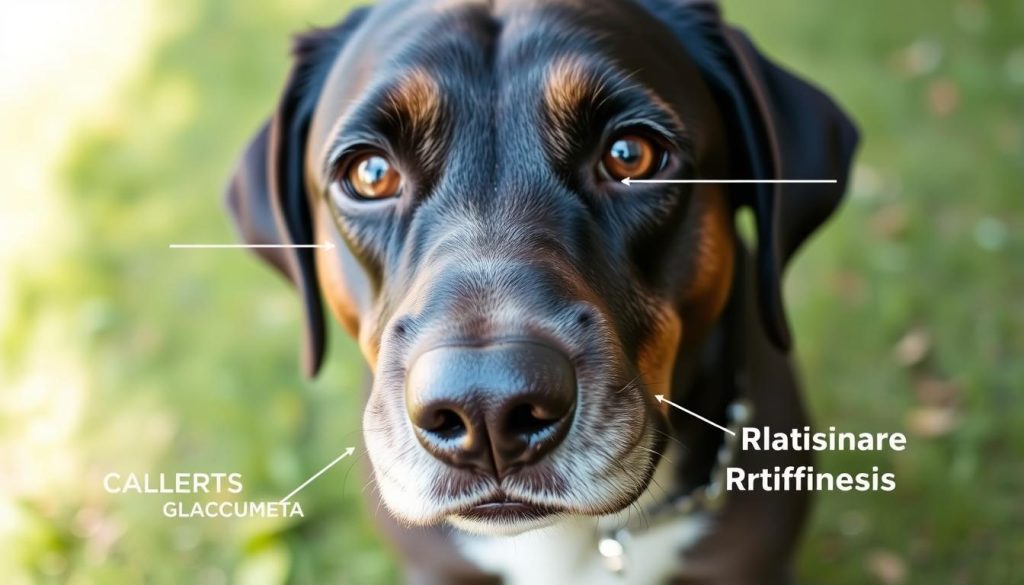Common Health Issues in Labrador Retrievers
Did you know Labrador Retrievers, a favourite in the UK, face many health problems1? They can suffer from hip and elbow dysplasia, obesity, and eye issues. These dogs are full of energy and love, but they have unique health challenges. In this article, we’ll look at common health issues in Labradors and how to prevent and manage them.
Key Takeaways
- Labradors are prone to joint issues like hip and elbow dysplasia, which can lead to arthritis and mobility problems.
- Obesity is a serious health concern for Labradors, increasing their risk of various diseases and shortening their lifespan.
- Ear infections and eye disorders, such as progressive retinal atrophy, are common in Labradors due to their physical characteristics.
- Responsible breeding practices and maintaining a healthy weight are crucial for preventing many Labrador health problems.
- Owners should be vigilant for signs of bloat, a life-threatening condition that requires immediate veterinary attention.
Introduction
Overview of Labrador Retrievers’ popularity and general traits
Labrador Retrievers are the most popular dog breed in the United Kingdom2. They are known for being friendly, outgoing, and easy to train2. They are great with families and often work as guide dogs, disability assistance dogs, and search and rescue dogs2.
Labradors are medium- to large-sized dogs, weighing between 65 to 80 pounds for males3. Females are slightly lighter3. They have a muscular build, wide skull, and a distinctive otter-like tail. Their double coat is water-resistant and needs regular brushing to manage shedding43.
Labradors need at least 90 minutes of exercise daily, best in two sessions4. They were bred for swimming and retrieving, making them keen water dogs4. It’s important to socialize them because of their sociable nature and high energy levels4. Owners should ensure they get proper diet, exercise, vaccination, and regular health checks4.
“Labrador Retrievers are known for their love of food, which can be used as a motivator in training but requires monitoring to prevent overeating.”4
Hip Dysplasia
Labrador Retrievers are more likely to get hip dysplasia5. This is because their hip socket forms abnormally, leading to joint damage over time6. Dogs like Labradors, German Shepherds, Pitbulls, Great Danes, and Saint Bernards often suffer from this6.
Symptoms include trouble climbing stairs, limping, and a ‘bunny hopping’ gait5. They may also feel pain, stiffness, and limp5. If not treated, it can cause severe arthritis later on5.
To lower the risk, it’s important to breed responsibly. Make sure breeding dogs have been checked for hip health before breeding5.
Non-surgical treatments include physical therapy, chiropractic care, and weight management6. Acupuncture, anti-inflammatories, massage, and supplements are also options6. In serious cases, surgery can cost between £800 to £5,500 per hip6.
The Ortho Dog Hip Hound brace is good for dogs with arthritis and mild hip dysplasia6. It’s important to start rebuilding strength with safe exercises to avoid muscle loss6.
Knowing about hip dysplasia in Labradors helps owners keep their pets healthy5.
Elbow Dysplasia
Elbow dysplasia is a common joint problem in Labrador Retrievers. It happens when the elbow joint grows abnormally, causing various issues7. This condition is more common in dogs than cats7. Most dogs with elbow dysplasia show swelling and pain in their elbows7.
Causes, Symptoms, and Treatment
Labradors can get elbow dysplasia due to several reasons. These include a broken medial coronoid process, osteochondrosis dissecans, ununited anconeal process, and medial compartment disease78. Symptoms include lameness, elbow pain, joint swelling, and reduced movement7.
Surgery is often needed to treat elbow dysplasia. It involves removing bone fragments and cartilage7. For FCP, removing bone fragments can help 60-70% of dogs improve7. But, OCD leads to arthritis after cartilage removal7. UAP usually needs surgery in young dogs, while MCD has a poor prognosis as cartilage loss is irreversible7.
Along with surgery, there are non-surgical ways to manage elbow dysplasia. These include controlling weight, exercising carefully, using hydrotherapy, supplements, and medication7. It’s important to know that all dogs with elbow dysplasia will get arthritis, even with surgery7.
It’s vital to screen for elbow dysplasia through X-rays. This helps breeders choose healthier animals, reducing the disease’s spread8. The UK elbow dysplasia scheme follows guidelines from the International Elbow Working Group8.
Elbow dysplasia affects many breeds, including Labradors8. It starts in puppies and can last a dog’s whole life. Only a few dogs with elbow dysplasia show signs of lameness8. The condition is highly heritable, showing a strong genetic link, and is more common in medium and large breeds8.
Labrador owners should be aware of the risks of elbow dysplasia. They should work with their vets to monitor their dog’s joints, get the right treatment, and think about breeding8.
Obesity and Bloating
Labrador Retrievers often face obesity and bloating, which are serious health issues. They tend to eat too much and can easily gain weight9. This can lead to heart, liver, and joint problems, as well as metabolic and respiratory diseases9.
Bloat is another major concern for Labradors. It’s a condition where the stomach swells or twists, which can be life-threatening9. Large breeds like Great Danes and Doberman Pinschers are also at risk, and Labradors are no exception9. Dogs with a family history of bloat or past experiences are more likely to get it9.
Overeating and swallowing air while eating or drinking can cause bloating in dogs9. Gastric Dilatation-Volvulus (GDV) is a serious twist of the stomach that also leads to bloating and needs immediate vet care9. Other causes include intestinal blockages, parasites, food allergies, and obesity9.
Keeping your Labrador at a healthy weight is key to avoiding obesity and bloating9. Bloat can be fatal, with a 10-23% mortality rate, and large dogs over 99 pounds face a 20% higher risk10. Quick vet care and preventive measures like gastropexy can help reduce these risks and costs10.

By focusing on your Labrador’s health and weight, you can prevent obesity and bloating. This ensures they live a long, happy life910.
What health problems are common in Labrador Retrievers?
Labrador Retrievers are a favourite in the UK, loved for their friendly and lively nature11. But, they can face health problems that owners need to know about. Issues like joint troubles and eye problems are common. Knowing about these health concerns helps in caring for them well.
Obesity is a big problem for Labradors11. About 8.8% of them are overweight or obese. Male Labradors, especially those that have been neutered, are more likely to be overweight. This can cause joint pain, breathing issues, and increase the risk of other diseases.
Ear infections are also common, especially in chocolate-coloured Labradors11. They are more likely to get skin diseases than black or yellow Labradors. Labradors can also get joint problems like hip and elbow dysplasia. These can lead to mobility issues and arthritis if not treated.
Labrador Retrievers may also face other health issues, including:
- Laryngeal paralysis, which can affect breathing
- Hypothyroidism, an endocrine disorder
- Progressive retinal atrophy, a condition that affects the retina1213
- Tricuspid valve dysplasia, a heart defect present at birth12
- Muscular dystrophy, a genetic disease with no cure12
Regular vet visits and preventive care are key to keeping Labradors healthy13. Knowing about these common health issues helps owners take steps to prevent them. This way, Labradors can live long, happy, and healthy lives.
Preventing Health Problems
Good breeding and care are key to avoiding health issues in Labrador Retrievers14. They face a higher risk of 12 health problems compared to other breeds14. Issues like arthritis, lipoma, and kennel cough are common in Labradors14.
Responsible Breeding
Reputable breeders check their dogs for health problems like hip and elbow dysplasia15. They also look for progressive retinal atrophy and heart disease15. It’s important for buyers to see proof of these tests before getting a puppy15.
This ensures puppies start life healthy15.
Proper Care Practices
Owners can also help prevent health issues in Labradors15. Obesity is a big problem in Labradors15. Overweight dogs may live up to three years less than slim ones15.
Keeping them at the right weight is key15. Clean ears and quick vet visits are also important15.
“Responsible breeding and proper care practices are essential for preventing health problems in Labrador Retrievers.”
Working with good breeders and caring for Labradors helps them stay healthy14. The study helps monitor and improve Labrador health14.
| Health Issue | Likelihood in Labrador Retrievers |
|---|---|
| Arthritis | 2.8 times more likely |
| Lipoma | 2.5 times more likely |
| Kennel Cough | 2.3 times more likely |
| Stiffness | 2.1 times more likely |
| Obesity | 1.6 times more likely |
| Lameness | 1.6 times more likely |
| Ear Infections | 1.5 times more likely |
The Royal Veterinary College studied 1,462 Labradors and 20,786 other dogs14. Their research sheds light on Labrador health concerns14. This helps owners spot and treat these issues early14.
Nutritional Dilated Cardiomyopathy
Labrador Retrievers are known for their friendly nature. Sadly, they can get a serious heart disease called nutritional dilated cardiomyopathy (nutritional DCM). This condition is linked to grain-free diets with peas, legumes, or lentils16.
Nutritional DCM makes the heart dilate and fail to work right. It causes symptoms like a fast heart rate, coughing, and trouble breathing. Dogs may also feel tired, lose their appetite, and even collapse16. The FDA has seen 515 cases in dogs and 9 in cats from January 2014 to April 201916.
The number of DCM cases has gone up, with 222 cases reported between December 2018 and April 201916. This shows a possible increase in this heart disease in Labrador Retrievers and other breeds16.
To prevent this, Labrador Retriever owners should feed a high-quality diet with grains. Grains are important because not having them in a dog’s diet can lead to nutritional DCM16. By choosing the right food, owners can keep their dogs healthy and happy.
| Breed | Dilated Cardiomyopathy Risk |
|---|---|
| Boxers | High risk17 |
| Doberman Pinschers | High risk17 |
| Great Danes | High risk17 |
| Irish Wolfhounds | High risk17 |
| Newfoundlands | High risk17 |
| Standard and Giant Schnauzers | High risk17 |
| Saint Bernards | High risk17 |
| German Shepherds | Medium risk17 |
| Cocker Spaniels | Medium risk17 |
| English Springer Spaniels | Medium risk17 |
| Portuguese Water Dogs | Medium risk17 |
Labrador Retrievers are not usually at risk for dilated cardiomyopathy. But, there’s been a worrying trend. Between January 2018 and April 2019, 47 Labrador Retrievers were diagnosed with this condition18. This rise, linked to grain-free diets, highlights the need to watch the nutrition and heart health of Labrador Retrievers closely.
“Dilated cardiomyopathy is the most common cause of heart failure in certain large breeds of dogs such as Boxers, Doberman Pinschers, Great Danes, Irish Wolfhounds, Newfoundlands, Standard and Giant Schnauzers, and Saint Bernards.”17
As scientists study the link between diet and heart health in dogs, Labrador Retriever owners must stay alert. They should ensure their dogs eat a balanced, grain-inclusive diet to lower the risk of nutritional DCM.
Eye Disorders and Genetic Testing
Labrador Retrievers are known for their loyalty and love. But, they can also face eye problems. Progressive retinal atrophy (PRA) is a hereditary disease that causes blindness. Cataracts are another issue, caused by genes or injury19.
Breeders play a key role in preventing these eye issues. They test their dogs for genetic diseases. In 2011, a study showed 74% of Labradors tested were healthy, 23% were carriers, and 2% had PRA19.
About 3% of Labradors carry retinal dysplasia/oculoskeletal dysplasia (RD/OSD). This can be spotted early. Since 2008, over 1,000 Labradors have been tested for this gene19.
Organisations like OptiGen offer free tests for PRA in Labradors and other breeds19. This is important because PRA in dogs likely has many genetic causes, just like in humans19.
By using genetic testing, breeders can protect the health of Labradors for years20.
| Eye Disease | Prevalence | Characteristics |
|---|---|---|
| Progressive Retinal Atrophy (PRA) | 2% affected, 23% carriers19 | Hereditary degeneration of retinal tissue, leading to blindness |
| Cataracts | N/A | Can develop due to inheritance or eye trauma |
| Retinal Dysplasia/Oculoskeletal Dysplasia (RD/OSD) | ~3% carriers19 | Condition detected through screening, retinal folds visible in puppies 8-16 weeks19 |

Breeders check their dogs’ eyes and do genetic tests to avoid passing on diseases20. The Eye Scheme has been around since the 1960s. It checks not just eyes but also eyelids, helping all dogs before breeding20.
The Eye Scheme also offers cheaper tests for older dogs. This helps breeders and owners make better choices20. New eye diseases are added if they affect at least 1% of dogs over three years20.
“Longitudinal data collection through certification of older dogs provides essential information for owners and breeders to make informed breeding decisions.”
By staying informed and using genetic testing, breeders can protect Labradors from eye diseases20.
Conclusion
While Labrador Retriever health issues can be a worry, good Labrador Retriever care and Labrador Retriever breeding can help a lot. Labradors are usually healthy, but owners need to watch out for hip and elbow dysplasia, obesity, heart disease, and eye problems21.
Getting puppies from trusted breeders who focus on health and temperament is key. Keeping Labradors at a healthy weight, exercising them enough, and feeding them well is also important. If a problem arises, seeing a vet quickly is crucial. This way, Labradors can live long, happy lives2223.
Being proactive about Labrador Retriever health and Labrador Retriever care is essential. Responsible Labrador Retriever breeding practices also play a big role. By staying informed and caring for their Labrador’s health, owners can have many happy years together212223.
FAQ
What are the most common health problems in Labrador Retrievers?
Labrador Retrievers often face hip dysplasia, elbow dysplasia, and obesity. They can also get bloating, eye disorders, ear infections, and joint issues. Some genetic disorders are common too.
What is hip dysplasia in Labradors and how is it treated?
Hip dysplasia is when the hip socket doesn’t form right. This causes the hip joint to wear out. Symptoms include trouble going up or down stairs and pain.
To lower the risk, dogs should be hip scored before breeding. Owners should ask to see these scores.
What is elbow dysplasia and how is it treated in Labradors?
Elbow dysplasia is a joint problem in Labradors. It’s caused by the elbow joint growing abnormally. Symptoms include pain and a ‘bunny hopping’ gait.
Surgery and physical therapy might be needed. Dogs should be elbow scored before breeding.
Why are Labradors prone to obesity and what health risks does it pose?
Labradors tend to overeat and gain weight easily. This increases the risk of heart and liver disease. It also leads to joint and skeletal problems.
They are at risk of bloat, a serious condition. Keeping them at a healthy weight is key.
What other health issues can affect Labrador Retrievers?
Labradors can also face laryngeal paralysis, hypothyroidism, and progressive retinal atrophy. They are prone to ear infections and heart disease like tricuspid valve dysplasia.
How can I help prevent health problems in my Labrador Retriever?
To prevent health issues, get puppies from responsible breeders. They should screen for common conditions. Keep your Labrador at the right weight and clean their ears.
Seek vet care quickly if you notice any problems.
What is nutritional dilated cardiomyopathy and how does it affect Labradors?
Nutritional DCM is a heart disease in Labradors fed grain-free diets. It makes the heart dilate and fail. A diet with grains can prevent this.
What eye disorders are common in Labradors and how can they be prevented?
Labradors can get progressive retinal atrophy (PRA) and cataracts. PRA causes blindness. Cataracts can come from genetics or trauma.
Responsible breeders test their dogs for these conditions. They also do genetic testing.
Source Links
- Common Health Problems in Labradors – https://www.purina.co.uk/articles/dogs/health/symptoms/labrador-health-problems
- Common Health Problems in Labrador Retrievers – https://lbah.com/breed-disease/labrador-retrievers-health-problems/
- Labrador Retriever: Traits, Health, Diet and Care – https://tibetandogchew.com/pages/breeds/labrador-retriever
- Labrador Retriever | Our Dog Breeds | Guide Dogs – https://www.guidedogs.org.uk/getting-support/guide-dogs/our-breeds/labrador-retriever/
- No title found – https://www.akc.org/expert-advice/health/hip-dysplasia-in-dogs/
- Labrador Hip Dysplasia: Signs and Treatments – Ortho Dog – https://orthodog.com/article/lab-hip-dysplasia-treatments/?srsltid=AfmBOopwfzCHEx4nSaYhIvVFxsvjhOQTTCnHWy-LSCPHtb9MLuxkT5RY
- Elbow Dysplasia Fact Sheet | Davies Veterinary Specialists – https://www.vetspecialists.co.uk/fact-sheets-post/elbow-dysplasia-fact-sheet/
- PDF – https://www.bva.co.uk/media/2791/chs-elbow-dysplasia-2019-v2-web-170419.pdf
- Is Your Dog’s Belly Bloated? Here’s What You Need to Know | Embassy Lakes Animal Hospital – https://embassylakesanimalhospital.com/blog/dog-bloat/
- How To Prevent Bloat In Dogs – https://www.pawlicy.com/blog/bloat-in-dogs/
- Labrador retrievers at risk of various health problems – https://www.biomedcentral.com/about/press-centre/science-press-releases/22-10-18
- 13 Common Labrador Health Issues to Look Out For: Vet Approved Guide – Dogster – https://www.dogster.com/dog-health-care/common-labrador-health-issues
- Labrador Retriever – https://www.pdsa.org.uk/pet-help-and-advice/looking-after-your-pet/puppies-dogs/large-dogs/labrador-retriever
- 12 health problems Labrador Retrievers are more prone to than other breeds, warn vets – https://www.countryliving.com/uk/wildlife/dog-breeds/a37019720/labrador-retrievers-higher-risk-health-problems/
- The Most Common Labrador Health Issues and How to Handle Them – https://www.walkinpets.com/blog/labrador-health-issues/?srsltid=AfmBOopSlWZBJGgYxNJV9HmP47E2f0ww4aajeU4Q6B920Mmbj70HLYkP
- FDA Investigates Potential Link Between Diet & Heart Disease in Dogs – https://www.fda.gov/animal-veterinary/outbreaks-and-advisories/fda-investigation-potential-link-between-certain-diets-and-canine-dilated-cardiomyopathy
- Dilated Cardiomyopathy in Dogs | VCA Animal Hospitals – https://vcahospitals.com/know-your-pet/dilated-cardiomyopathy-dcm-in-dogs–indepth
- No title found – https://www.akc.org/expert-advice/nutrition/dilated-cardiomyopathy-dogs-update/
- Eye Exams & Genetic Testing Help Breeders Reduce Blindness In Labradors – https://www.purinaproclub.com/resources/dog-articles/health/eye-exams-genetic-testing-help-breeders-reduce-blindness-in-labradors
- PDF – https://www.bva.co.uk/media/2811/20190710-chs-eye-disease-guide-0719-v1-web.pdf
- The Most Common Labrador Health Issues and How to Handle Them – https://www.walkinpets.com/blog/labrador-health-issues/?srsltid=AfmBOoov4xoZ88SfLNsI0Q5PMlCECZ1wxcsn9VQFYnz6RrFaIXLwp3LS
- Disorder predispositions and protections of Labrador Retrievers in the UK – https://www.ncbi.nlm.nih.gov/pmc/articles/PMC8280121/
- Labrador retrievers under primary veterinary care in the UK: demography, mortality and disorders – Canine Medicine and Genetics – https://cgejournal.biomedcentral.com/articles/10.1186/s40575-018-0064-x

